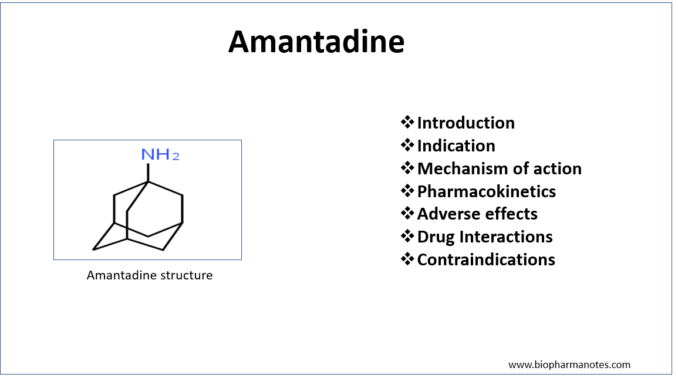
- Amantadine is an antiviral agent with mild anti parkinsonism activity. It is tricyclic amine.
- It was approved by US FDA in 1976 as antiviral agent.
Indications of amantadine
- It was initially discovered and used as antiviral agent for influenza A treatment. Due to emergence of high level of resistance, its use as antiviral agents is not recommended by CDC nowadays.
- Now, it is used in Parkinson’s disease for symptomatic improvement as it helps to ameliorate tremor, bradykinesia and rigidity. It is used as adjunct with levodopa.
- Some non- FDA approved uses are restless leg syndrome, traumatic brain injuries.
Mechanism of action of amantadine
- Its anti-parkinsonian activity is because of its ability to release dopamine in striatum. It is weak, non- competitive antagonist of NMDA receptor and hence increase dopamine release and prevent dopamine uptake. It also has some antimuscarinic action.
- Its antiviral action is due to its ability to inhibit viral uncoating which is an early step of viral replication. In some strains, it can inhibit late step in viral assembly. Its action against influenzas A virus is due to interference with viral M2 protein leading to blocking of uncoating of viral particle and prevention of virus release.
Pharmacokinetics of amantadine
- It is administered orally once per day or in divided doses. Also available as syrup form. It is well absorbed after oral administration.
- It is distributed throughout the body. Amantadine can penetrate inside the CNS (Central Nervous System). Most percentage of amantadine administered is excreted unchanged in urine. Hence, its elimination half-life increases by around two times in elder patients and increment is more in renal dysfunction. Dosage adjustment is required in elder patients and patients with renal dysfunction. It is also excreted in breast milk.
- Its half-life may range between 10- 30 hours. It may take four- seven days to reach steady state concentration.
Adverse Effects
- It is well tolerated drug and has low side effect profile.
- Some common side effects are syncope, orthostatic hypotension, delusion, hallucination, peripheral edema and xerostomia. It can cause GI related side effects like constipation.
- Some serious side effects are CNS depression, suicidal tendency, neuroleptic malignant syndrome and psychosis. Large doses can cause convulsion and mania.
Drug Interaction
- It potentiates adverse effects of anticholinergic drugs.
Contraindication
- Should be used with caution in pregnant and nursing mothers. It is pregnancy category C drug.
- Contraindicated in patients with hypersensitivity to amantadine.
- Extended release dosage form of amantadine is contraindicated in patients with end stage renal disease (ESRD).
- Contraindicated in patients with epilepsy and other CNS disease.
- Should be used with caution in elderly patients.
References
- https://www.ncbi.nlm.nih.gov/books/NBK499953/
- Hosenbocus S et al. Amantadine: A Review of Use in Child and Adolescent Psychiatry. J Can Acad Child Adolesc Psychiatry. 2013 Feb; 22(1): 55–60.
- Pharmacology and Pharmacotherapeutics. 24th edition.
- Goodman and Gillman Manual of Pharmacology and Therapeutics.
- Lippincott Illustrated Reviews Pharmacology, 6th edition